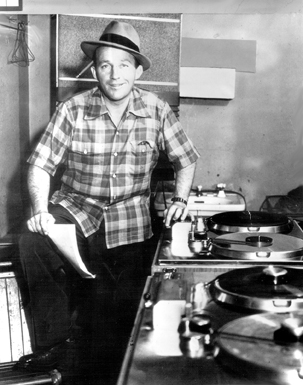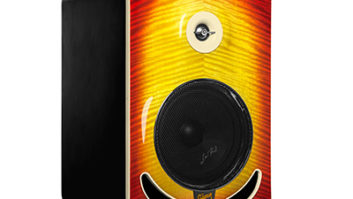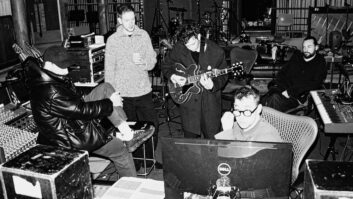

Every revolution needs its leader—the provocateur—the central figure in which everything emanates from and flows through. In the case of 20th century music and mass media technology, the figure having the greatest impact was not an inventor or scientist, but rather a singer.
And that singer was none other than Bing Crosby. Without question, he was the original superstar of multimedia and even when compared to the icons that followed him (Sinatra, Elvis, The Beatles and Michael Jackson), is probably still the biggest. His White Christmas was the No. 1 recorded song in total sales (35+ million) for over 50 years. And for sheer volume, the 1,600 records he made have never been equaled. He performed on a staggering 4,000 radio shows, appeared in 300 television programs, 100 movies, and was the first popular singer to win a Academy Award for Best Actor (Going My Way, in 1944).
Along with his success, he gained enormous wealth and became an independent force to be reckoned with in the midst of the corporate powers that dominated the radio, film, and music industries. And because of his artistic need to innovate new methods of reproducing himself, he used his power to nurture the major technological developments of the past half century. Simply put, if it was not for Bing, music and mass media as we know it would be radically different.
To fully appreciate Crosby’s gargantuan impact, it’s important to understand where technology was in the 1940s. Magnetic tape recording, for all intents and purposes, did not yet exist. Recordings were made directly to disc—as they had been for over 40 years. Though the world of audio had come quite a way since Alexander Graham Bell invented the telephone, the jump to hi fidelity sound was still around the corner.
It is amazing to realize how far we have come in a relatively short time (at least in reference to all of human history). And it is surprising to understand how great a role Bing Crosby played. But in order to fully grasp his role as chief provocateur, it is necessary to know about the two main men whose lives converged with him and forever changed how sound is made and reproduced.
Like thousands of other GIs just before D-Day in 1944, Jack T. Mullin was in England. Assigned to the Signal Corps, he was troubleshooting a problem the Army was having with radio receiver interference.
Working until two or three in the morning, he wanted music to listen to, but unfortunately, the BBC broadcast only until midnight. In searching for music at that hour, he discovered German stations that were broadcasting very well played symphony concerts—apparently twenty-four hours a day.
The American networks wouldn’t permit the use of recordings in the early 1940s, because they claimed the quality was inferior. You could always spot the surface noise and the relatively short playing time of commercial 78-rpm discs. But there was none of this in the music coming from Germany. The sound was comparable to that of a live broadcast, and a selection might continue for a quarter of an hour or more without interruption.
THE MAGNETOPHON

In Germany at that stage, of course, Hitler could have anything he wanted. If he wanted a full symphony orchestra to play all night long, he could get it. Still, it didn’t seem very likely that even a madman would insist on live concerts night after night. There had to be another answer, and Mullin was curious to know what it was.
After the liberation of Paris, as the Allied armies moved on Berlin, Mullin’s unit was reassigned to Paris and given the job of discovering technological developments that the Germans had made in electronics during the war. That meant taking trips into Germany from time to time. And on one of those trips, he met a British army officer who raved about the quality of the Magnetophon (the term that Germans used for all recording devices) at Radio Frankfurt. Figuring this officer simply didn’t have a good ear, Mullin assumed that the machine in question was no different than the noisy wire recorders that were commonplace.
On the way back to his unit, he came to the proverbial fork in the road. Turn right and drive straight back to Paris, or turn left, to Frankfurt. Turning left was the greatest decision of his life. At the time, the radio station was operated by the Armed Forces Radio Service and when the Magnetophon was demonstrated, Mullin flipped. There was no background noise—the music sounded live. The answer to his question about where all that beautiful night-music had come from was finally answered.
Although these machines had been used at a number of stations in Germany, there was no official word that such a thing existed. The people who were using it to prepare radio programs apparently were unaware of its significance.

JACK MULLIN’S REDISCOVERY
Upon finding more of these machines, Mullin kept two for myself, photographing the manuals and schematics. During his last months in the Army, he took the machines apart and sent them home to San Francisco in pieces. Regulations specified that a war souvenir had to fit inside a mailbag, so he made little wooden boxes for the motors, shipping each one separately. In all, it came to 35 separate items. Any one of those boxes could have been lost or damaged, but miraculously, all of them arrived safely. In a addition, he sent all the magnetic recording tape he could find.
After reassembling the machines in San Francisco, early in 1946, he started showing them to audio professionals. And at one of those early demonstrations, a representative of the Ampex Corporation was looking on keenly. That company had been making aircraft motors during the war but was now looking for a new product, and tape recorders well could be the ticket. As it turned out, Ampex did in fact become the U.S. pioneer in the field.
In mid-1947, before Ampex was in production, Mullin was invited to give a demonstration for Bing. The previous year, Crosby wanted to shift from live performance to recorded transcriptions for his weekly radio show on NBC sponsored by Kraft. But NBC refused to allow recorded radio programs (except for s). Even though Bing was radio’s biggest star, the live production of radio shows was a deeply established tradition (reinforced by the union) that the network was not willing to dispense with. The new ABC network was willing to break the tradition and pay Crosby $70,000 per week to produce a 60 minute recorded show every Wednesday. Crosby wanted to change to recorded production for several reasons. The legend that has been most often told is that it would give him more time for his golf game.
But golf was not the most important reason. Bing was always an early riser and hard worker. He sought better quality through recording, not more spare time. He could eliminate mistakes and control the timing of performances. Also, he would no longer have to wear the hated toupee on his head previously required by CBS and NBC for his live audience shows (Bing preferred a hat). He could also record short promotions for his latest investment, the world’s first frozen orange juice to be sold under the brand name “Minute Maid.”
Bing’s problem was that his new network threatened to cancel the show during the first year because the audience rating was falling off – and this was blamed on the poor audio caused by editing on multiple transcription discs. Crosby needed to act fast and find a viable solution. What Jack Mullin didn’t know was that Bing had already seen a tape recorder. It turns out that Colonial Richard Ranger had also found a Magnetophon, shipped it back to Newark, New Jersey, put it back together and then made a copy he ingeniously called the Rangertone.
Figuring that Les Paul would be more interested in his machine than just about any other human being, Ranger tracked Les down and regaled him with his story. Not surprisingly, Paul was absolutely intrigued, but having had ongoing conversations with Bing about his immediate quandary, had Ranger fly out to Hollywood to demonstrate the recorder to Crosby’s staff. Although they were impressed with the machine, they were less than impressed with Ranger’s apparent lack of motivation. Knowing they needed at least two working machines, Ranger did the opposite of “seizing the moment,” matter-of-factly informing them he could only make one Rangertone per year.
Mullin on the other hand already had two machines and impressed the staff with his know-how, so was invited back to record Crosby’s first show of the 1947-48 season. Crosby’s technical people wanted to see how tape would compete with the disc system they had been using. They liked what they heard and asked Mullin to set up shop in their Hollywood studio and become chief engineer. His tools were exactly what he sent from Paris—two recorders and 50 rolls of tape. With those 50 rolls, he was able to do 26 shows: splicing, erasing, and recording over the splices. The concept of splicing magnetic recording tape had never been contemplated, so techniques had to be developed.
Everything was recorded, even afternoon rehearsals. As Bing wrote in his autobiography, “By using tape, I could do a 35- or 40-minute show, then edit it down to the 26 or 27 minutes the program ran. In that way, we could take out jokes, gags, or situations that didn’t play well and finish with only the prime meat of the show; the solid stuff that played big. We could also take out the songs that didn’t sound good. It gave us a chance to first try a recording of the songs in the afternoon without an audience, then another one in front of a studio audience.”
“We’d dub the one that came off best into the final transcription. It gave us a chance to ad lib as much as we wanted, knowing that excess ad-libs could be sliced from the final product. If I made a mistake in singing a song or in the script, I could have some fun with it, then retain any of the fun that sounded amusing.”
In the evening, Crosby did the whole show before an audience. If he muffed a song then, the audience loved it -thought it was very funny, but Mullin would have to take out the show version and put in one of the rehearsal takes. Sometimes, if Crosby was having fun with a song and not really working at it, he would have to make it up out of two or three parts. This way of working became commonplace in recording studios, but it was a whole new game in 1947.
Clearly being the wave of the future, Crosby invested in Ampex in order to mass-produce machines. Midway through the next year, Ampex finally released their first machines (modeled on the Magnetophon) and the first two were presented to Mullin. This enabled him to retire his, which were showing signs of fatigue. Additionally, the 3M company was now making blank tape (based on the BASF tape brought back from Germany), so they no longer had to rely on the original 50 reels.
Within a short time, the tape recorder revolution was in full blast and a new, modern era of broadcasting and music was about to change all our lives. How ironic that it all led back to a fork in the road outside Frankfurt.
For history’s sake it must be noted also that many of the technical parameters that Mullin developed still are the worldwide standards for tape recording. Oh, and one other thing that probably casts an even larger cultural footprint. Crosby looked to take his act over to that newer medium, television. Production was mostly live in its early years but he wanted the same ability to record that he had achieved in radio. So, in 1950, in order to help facilitate his boss’s needs, Jack Mullin developed the world’s first working video tape recorder. And over the next few years, through his investment in Ampex, Bing continued to finance the development of videotape.
THE LES PAUL INFLUENCE
If Jack Mullin is the Godfather of tape recording, the Pope of popular music, the person who has undoubtedly had more influence on the sound of music over the last half century is none other than Les Paul (the very man who first hipped Bing to magnetic tape recording). Unlike Mullin, whose name and story were familiar mainly to those inside the industry, the very name “Les Paul” conjures up powerful musical images and is recognized in all corners of the globe.
Of course Les is most known for the rip-roaring guitar that bears his name. Along with Leo Fender and Adolph Rickenbacker, he is the inventor of the solid-body guitar—the instrument that gave rock music its volume and voice, enabling it to explode. A musician himself, he was a highly versatile guitarist who gained nationwide exposure in the late-30s and early-40s through a variety of radio programs and recordings. Dissatisfied with the sound of available electric guitars, he set out to build his own and created “The Log,” which was nothing more than a length of common 4×4 fence post with bridge, guitar neck, and pickup attached.
In 1951, years after first presenting his creation to the Gibson company, they finally decided to manufacture and market an updated version of “The Log,” only after Fender and Rickenbacker beat them to the punch and released their own solid body instruments. Even if that was his sole contribution, it would still place him in the pantheon of giants because Les Paul guitars are sold to this day and are continually used to create some of the world’s most memorable music.
But his pioneering work in the world of recording is even more monumental and touches each of us virtually every day. Every time you hear music that has been recorded after 1947, you can’t help but feel Les Paul’s influence.
In 1944, Les hooked up with Bing Crosby, who featured the Les Paul Trio on his radio show and recorded six records with him, including a 1945 number one hit, “It’s Been a Long, Long Time.” On his own, Les continued to make jazz, country and Hawaiian flavored recordings in addition to backing other popular singers like Judy Garland, Dinah Shore and the Andrews Sisters.
By 1946, on Bing’s advice, Les had built a studio in his garage and was recording his own masters at home – experimenting and ultimately pushing the envelope of what could be done with recorded sound. His first major breakthrough was a song called “Lover,” a sonic wonderland containing eight layers of rhythm and lead guitars, all played by himself. Amazingly, this recording pre-dates magnetic tape—made only with wax disks. In essence, Les created the world’s first multitrack recording system by jerry-rigging two disc cutting lathes. He would record a track onto a disk, then record himself playing another part with the first, and then so on down the line. Capitol Records released the song in 1948, billing the astounding, futuristic recording as “The New Sound.” Not surprisingly, it became a hit.
At this same time, Paul was becoming involved with Colleen Summers, a singer he would marry the following year. While driving on Route 66 outside Oklahoma City, their car slipped on ice, crashing through a guardrail and dropping 20 feet into a frozen creek. Although lucky to be alive, it looked like Paul would never play guitar again as his right arm was shattered in three places. Doctors grafted bone from his leg into his arm and rebuilt his elbow with a steel plate, which had to be locked into place. Demonstrating his utter commitment to craft, Les instructed the surgeons to set his arm at a 90-degree angle that would allow him to cradle and pick the guitar. The arm would be in a variety of casts for the next 18 months.
THE TAPE CONNECTION
During Paul’s convalescence, Bing dropped by with a gift: the first Ampex 300 series tape machine. After studying it for a while, Les realized that by modifying his new toy with an additional record head, he would be able to record multiple parts, creating his “sound-on-sound,” with far greater fidelity and control than he had with his disc system. And with that, he effectively gave birth to the multitrack tape recorder as we know it today.
In the beginning of Les’s tape experiments, it was just him, playing on his own. Soon though, he added his country singing wife, who was given the stage name Mary Ford. Paul overdubbed multiple generations of his wife’s silky voice, making her sound like a one woman Andrew Sisters. Les’ country- jazz licks and studio wizardry now had the perfect foil, and the results were stunning. Their first multitrack hit, a cover of “How High the Moon,” was released in early 1951 and reached No. 1. This began a string of 28 spectacular multi-layered hits on Capitol Records, highlighted by three #2 records and the gargantuan, “Vaya Con Dios,” which stayed at #1 for 11 weeks in 1953. Not only did these recordings sell over 10 million copies, their success enabled Les Paul and Mary Ford to have their own television show.

Mullin with the Ampex 200s
But even more importantly, the creation of new recording techniques and the constant refinement of those techniques would have an even longer lasting effect than even the music itself. Along with sound on sound recording, Paul discovered tape delay—which became an essential element of early rock, starting with the immortal Sun recordings of Elvis and Jerry Lee Lewis. He created artificial reverb and other never-heard effects. He used Air Force pilot headphones to listen to the music while recording new parts. To lessen the tape noise caused by recording up to 37 generations, he designed equalizers and amplifiers to provide the optimum results.
Another huge advancement that Les pioneered was close miking vocals. Previous to this there was an unwritten rule that vocalists should be placed no closer than two feet from the microphone. Les wanted to capture every nuance of Mary Ford’s voice so he had her stand only a couple of inches away from the mic. It sounded so good that soon, everybody began recording vocals this way. Les even invented the idea of octave-transposed voices that eventually provided the basis for the television cartoon “The Chipmunks” with his friend Ross Bagdasarian (David Seville). No one had ever heard things like this before. From Les Paul’s garage, the sound of the future was created.
ENTER THE MULTITRACK
In 1952, Les gave a speech to the Audio Engineering Society stating that multitrack recording was the future, and begged for the invention of higher quality speakers and amplifiers. During the same speech, he let it all hang out – previewing the future by pitching the idea of a digital recording system that would replace the analogue systems (that were just beginning to be developed) and enable multitracking without the inherent problem of tape hiss and noise. Les was so far in front that he was looking towards new technology to replace things that hadn’t even been built yet.
In 1954, the audio world was speechless as Les commissioned Ampex to build the world’s first 8-track tape recorder. His creation of “sound on sound,” later known as “Sel-Sync,” in which a recording head could simultaneously record a new track and playback previously recorded ones, would firmly establish the future of multitrack recording.
Surprisingly, the record industry didn’t catch up to multitrack recording for several years. For some reason, many of the old-line powers that be thought that Les’s innovations were more of a novelty. It took about five years before they began making background recordings and putting a singer on later. Among the first to do this were Ray Charles and Patti Page, but it wasn’t done seriously until the very late fifties and early sixties. From there, things just exploded over the next few decades. Four-track to 8-track to 16-track to 24-track analog tape machines—making way to 48-track digital tape machines, eventually making way to the computer based digital audio workstations of the present—with unlimited tracks and manipulation capabilities that years ago would have been unthinkable to everyone. Probably everyone but Les Paul, that is.
Quite simply, it is impossible to overstate Les’s contribution to music and sound reproduction. He is both the father of rock guitar and the father of modern recording. He gave birth to and nurtured multi track recording, overdubbing, artificial reverb and echo, effects like delay and vari speed. He pioneered the use of close miking. He continually invented and then refined the techniques that enable rock, pop and every other style of music to be created in the way it does, and ultimately sound the way it does. Whole volumes have been and will continue to be written about him – and for good reason.
The bottom line? Our world would certainly not sound the way it does without Bing Crosby and the men he intersected with.
This is a chapter researched for the upcoming book Moses Never Ate Scampi by producer/engineer/label exec Steven Miller and is used with the kind permission of the author.






